Pure separation and sorting of microparticles from complex fluids are essential for biochemical analyses and clinical diagnostics. However, conventional techniques require highly complex and expensive labeling processes for high purity separation. In this study, we present a simple and label-free method for separating microparticles with high purity using the elasto-inertial characteristic of a non-Newtonian fluid in microchannel flow. At the inlet, particle-containing sample flow was pushed toward the side walls by introducing sheath fluid from the center inlet. Particles of 1 μm and 5 μm in diameter, which were suspended in viscoelastic fluid, were successfully separated in the outlet channels: larger particles were notably focused on the centerline of the channel at the outlet, while smaller particles continued flowing along the side walls with minimal lateral migration towards the centerline. The same technique was further applied to separate platelets from diluted whole blood. Through cytometric analysis, we obtained a purity of collected platelets of close to 99.9%. Conclusively, our microparticle separation technique using elasto-inertial forces in non-Newtonian fluid is an effective method for separating and collecting microparticles on the basis of size differences with high purity.

You have access to this article
 Please wait while we load your content...
Something went wrong. Try again?
Please wait while we load your content...
Something went wrong. Try again?


 Please wait while we load your content...
Please wait while we load your content...